Not without my dog! Do you love riding your bike but hate leaving your best friend behind? In that case, a dog trailer should form as much a part of your basic gear as a leash and a basket. We tested 9 dog trailers from 5 brands to find out what you need to consider before buying and while riding.
Your dog is happiest when they’re with you – at work, on holiday, in the car, and when riding. And because this isn’t always possible on their own four paws – for a variety of reasons – it’s best to tow them along in a dog trailer. Sounds simple, right? Unfortunately, it isn’t quite as simple as it sounds. Choosing the best trailer for your dog is almost as complicated as configuring your bike. Size, interior upholstery, accessories, with or without suspension – these are just some of the aspects to consider. It continues with questions like: is the trailer foldable, does it have brakes, and will your dog feel comfortable? It can all get more complicated than planning a bikepacking tour through northern Sweden. To complicate matters, there are huge differences in price and performance.
We want to help you make the right decision and tested 9 models from 5 different brands, including Croozer, Hamax, Burley, TAXXI and TRIXIE, with prices ranging from € 349 to € 1,299. We gained a few surprising insights along the way.

Our test crew
We know quite a lot about bicycles – that’s our job. But now a crucial component has been added, our four-legged friends. So we grabbed 5 bikes, 5 completely different dogs and 9 dog trailers, filled our bags with treats and snacks, and rode through thick and thin.
Quiz:Who’s Hound’s Who’s? As you know, masters look like their dogs… For the curious: our test crew.
Our test riders:

The off-road queen – it’s in her surname (Feder means Spring in German). So, suspension wanted!

The commuter and speeder. For him, stable handling is paramount.

Enjoys la dolce vita, and places a lot of importance on looks and design.

Enjoys cruising around the city, so she needs reflectors, lights, flags, and an easily foldable trailer that she can store in the basement.

Our roadie, who enjoys long rides, and values the added storage of pockets and the convenience of a rain cover.
Our test doggos:

Age: 11 years
Weight: 20 kg
Facts: Can’t run long distances, because he starts hobbling, but he takes everything else in his stride and also likes riding on the upper deck.

Age: 5 years
Weight: 35 kg
Facts: The most experienced trailer tester of all. For ultimate dog happiness, he needs an open window to feel the wind in his mane.

Age: 10 years
Weight: 30 kg
Facts: His paw was maimed on the streets. He’s also just had surgery on his knee and loves a side exit so that he doesn’t have to turn.

Age: 3 years
Weight: 24 kg
Facts: Maya is a rescue and doesn’t always like new situations. For her, an integrated dog leash is an important feature, even if she doesn’t always agree.

Age: 3 years
Weight: 9 kg
Facts: Growing up as a Greek street dog, he was hit by a car and now has a deformed paw. He needs help climbing in.
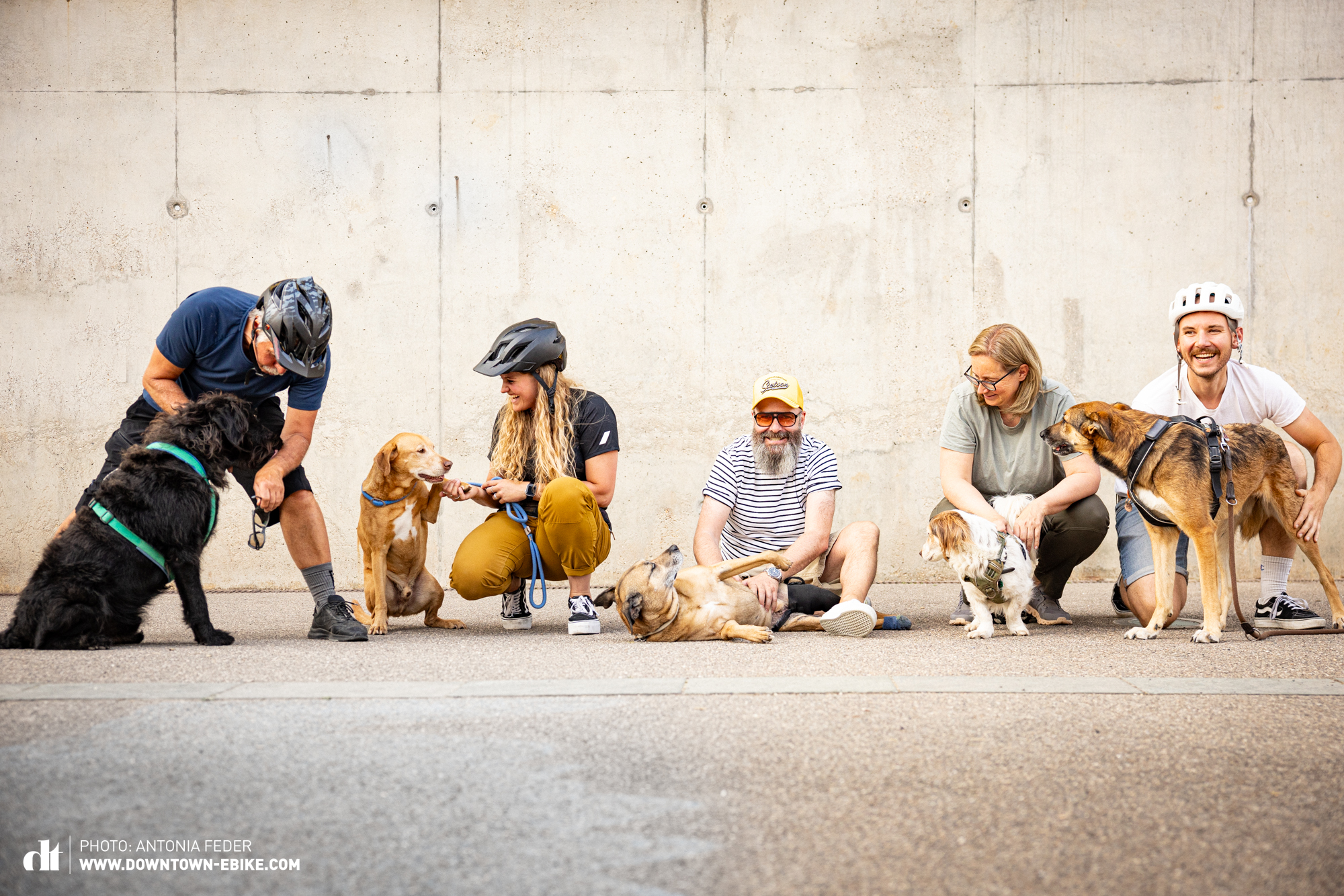
The test conditions
Dog bike trailers must deal with a wide variety of situations and conditions. Therefore, our test track had to simulate this as realistically as possible, making our test dogs, riders and trailers navigate busy city traffic, various obstacles, cobblestones, curbs, potholes, and gravel as well as woodland paths. In addition to how they behave behind the bike, we also tested the dog trailers’ handling off the bike: how do the dogs enter and exit, and how easy are the trailers to assemble, disassemble, and attach to the bicycle hitch. Since suspension is a hotly debated topic, we paid special attention to this in our tests: using accelerometers, we repeatedly tested the forces exerted on the trailer bed of each trailer with different weights.
The test field at a glance: 9 dog trailers



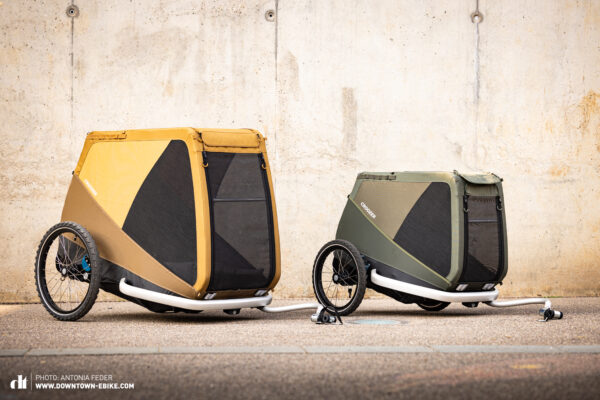
Croozer Dog Enna | max. dog weight: 35 kg | trailer weight: 16.08 kg | € 999.00 | review here

Hamax Pluto Medium | max. dog weight: 35 kg | trailer weight: 19.4 kg | € 749.00 | review here

TAXXI DOG M | max. dog weight: 25 kg | trailer weight: 12.96 kg | € 549.00 | review here
Which is the best dog trailer for me and my dog?
Everyone has different needs and desires, and it’s all a matter of taste – this applies to dogs as well as their owners. Below, you will find an overview of what you should pay attention to. We often have a tendency to over-do it with our equipment, running around in light drizzle wearing a Himalayan expedition jacket. The same applies to dog trailers: there are a lot of cool functions, but do you really need them, and are they any good?

Dog size and weight
First of all, you should check that you choose the right dog trailer for the size and weight of your dog. Check that your four-legged friend will be able to get in easily and that the entry isn’t too high, and whether the trailer should have side entry and exit due to injury or other reasons. In order for your dog to be able to stand in the trailer, you should also compare the interior height and the height of your dog.



Trailer size
Does your dog predominantly ride lying down, or do they sit up or even stand while you’re riding? Accordingly, you should pay attention to how large the bed of the dog trailer is and how many windows it has for your dog’s sightseeing pleasure.


Rider types
Are you more of a sporty rider who also likes going off-road, or riding an eMTB? Or do you prefer taking it easy? If it’s the former, you should pay more attention to a sturdy construction, wide tires, generous ground clearance, and as low a centre of gravity as possible.


Assembly and disassembly of the dog trailer
How easy is the trailer to assemble and disassemble? If you often go on holiday, or have to store the dog trailer in a cramped basement, you’ll want an easily foldable dog trailer. Check how small it can be folded down, and test whether it’s easy to take apart by yourself before handing over your cash – pinch points can be annoying, not to mention painful. To make sure that the trailer (or at least the main dog-box) fits in your trunk, you should also check how big the dog trailer is without the wheels and drawbar.



Hitching the trailer to the bike
How quickly and easily can you hitch the dog trailer to your bike? This is especially important if you frequently switch between riding with and without the trailer.
Buggy function
The buggy function is interesting for particularly athletic dog owners who don’t just want to ride a bike, but also go jogging or for a (say it quietly) *walk*. If you have a dog that is physically handicapped and can’t walk that far, it’s a great feature. Take note of how often you’ll have to disassemble the buggy handle when not in use. Depending on the trailer, this can be a more or less fiddly procedure.
Standard spec and optional extras
When it comes to the purchase price, it’s always worth checking what you get for your money. Depending on the brand, there are big differences here. In some cases, useful features come as standard, while they’re merely accessories, available as optional extras in other cases. This is the case with the most expensive brand on test, Croozer, where almost every accessory will cost you extra. So, first check whether the rain cover, dog bed, battery-operated tail light, buggy kit, and pockets for things like leashes, water bowls, or treats are included. Also important: does it come with a safety leash, and what about reflectors and lights?


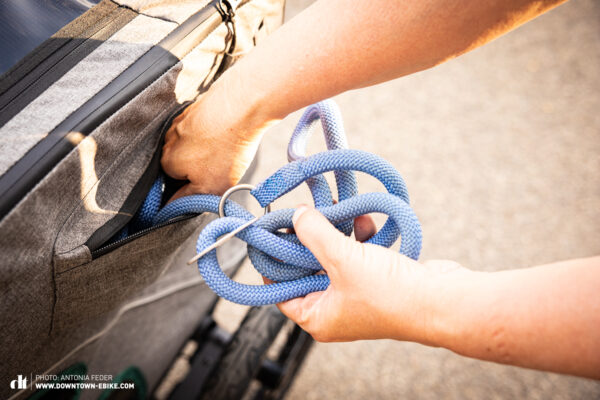

Cleaning the dog trailer
Your dog bike trailer will get dirty, so you will eventually have to clean it. The best option is a removable interior that you can simply shove into the washing machine. Not an option? Then you’re left with no other option but to hose it down.

Spares
When something breaks, the best solution is if you can get replacement parts from the manufacturer. Components such as tires, tubes, and spare thru-axles are typically available from most bike stores.
Cargo bike or dog bike trailer?
Some of you will wonder if a cargo bike isn’t the better alternative. If you ask us, this is only worth considering if you’ve got an experienced and relaxed dog, as the handling is a lot more shaky, requiring the rider to keep everything balanced.
Suspension and a dog bed
First of all, if you have a dog trailer without suspension, a thick and well-padded dog bed almost offers the same level of comfort. More on this below.
What to keep in mind about the bike?
Let’s start with what’s permitted: dog bike trailers may only be pulled by analogue bikes and ebikes with 25 km/h cut-out. In general, this applies to all European ebikes, regardless of the motor. Whether you need a motor depends on your fitness level, the dog, and the terrain. While you’ll easily pull a poodle in a flat city like Hamburg, but you might need a little help pulling a Rottweiler in hilly Stuttgart.

Brakes
To pull the trailer with confidence despite the heavy load, large brake rotors offer significant advantages in terms of stopping power and safety. If your bike has ABS, like the Bosch ABS system, you benefit from improved brake force distribution in critical situations, without locking the wheels. Since the added weight of the trailer leads to increased braking traction, you’ll want to make the most of this with aggressive, knobbly tires when riding off-road. The tread of the trailer’s tires is secondary – they’ll generally roll along quite happily regardless, as they don’t have to handle any of the power transfer or braking forces.


Permissible gross vehicle mass (GVW)
The permissible GVM for the bicycle and trailer combination includes the weight of the bike, the rider’s weight including their kit (helmet, backpack, etc.) as well as the weight of the trailer and the dog. In Europe, the GVM of the trailer alone is always subject to a 60 kg limit, which the combined weight of the dog and trailer may not exceed. But who’s going to have to lose weight if you exceed the combined permissible GVM? You or the dog? For an in-depth look at this complex topic, check out the article we wrote about it here.
Thru-axle and hitch
To attach the trailer to the bike, you will first have to fight your way through the thru-axle jungle. Unfortunately, there is no standard for thru-axles. Thru-axles differ in both length (from 161 mm to 229 mm) and thread pitch (1.0 mm, 1.5 mm and 1.75 mm). Almost every bike needs a different thru-axle – and that can become a daunting challenge! For ebikes with a hub motor, relying on a fixed axle, you may need a special adapter. In that case, you’ll have to consult your bike dealer.


Does suspension make sense for a dog trailer?
Many potential buyers specifically want a dog trailer with suspension. But does this feature actually provide a more comfortable ride for your dog? Among the 9 models on test, 7 had suspension – Burley are the only brand that swim against the stream.
Suspension is available in a wide variety of configurations and designs: using elastomers, or relying on coil shocks; some adjustable, others automatically adaptive. Another option is adjusting the position of the wheels and thus the leverage ratio, depending on the weight of the dog. Some brands boast of coil shocks that are infinitely adjustable. However, if you only tighten or loosen the coil, all you’re changing is the spring preload and thus the response. If you want to learn more about the intricacies of suspension, you can check out the in-depth look at coil vs air springs conducted by our sister publication, ENDURO.



Since we don’t speak dog and couldn’t get their feedback, we equipped all trailers with accelerometers to test whether dog trailer suspension actually works. We tested a wide range of settings on the trailers with adjustable suspension, using different weights, and we tested them with and without a dog bed. Spoiler: the dog bed has a big impact!

First of all, you must distinguish between two things: stability, and dog/rider comfort. Stability is especially important through the corners. Due to centrifugal forces, the weight shifts when you corner, which can be further intensified by a change in the position of the dog and, in extreme cases, can cause the trailer to tip. Cornering grip is not important for the trailer, as the cornering is done by the bike. Regarding the dog’s comfort, the biggest bumps usually come from riding over curbs, cobblestones, or on woodland paths. The rider has their own suspension on the bike, so their comfort is irrelevant at this point.



Without a doubt, an unsuspended dog trailer will always deliver a bumpier ride than a model with suspension, but not if there is a dog bed in the trailer! All trailers, with and without suspension, did a better job of absorbing shocks with a dog bed than without. For models with adjustable suspension, the soft settings usually perform better. However, soft suspension responds more sensitively to centrifugal forces, too, causing the load to shift more drastically through the corners. Unless you’re careful, the trailer could tip over. That’s the reason why sports cars have such firm suspension. As you can see: a dog trailer with suspension isn’t necessarily better and, depending on the riding style, it can even affect your beloved pet’s safety. Our conclusion: with the right dog bed, there is no need for suspension!

A dog bed – The game changer?
In short: a well-padded dog bed offers just as much comfort as suspension! If a dog bed isn’t included with the trailer as standard, we recommend buying one, as it significantly improves the comfort of your dog. Of course, any extra gadgetry is always cool and exciting, but if we had to decide, we would choose a model without suspension and invest the difference in a high-quality dog bed instead. An unsuspended dog trailer with a dog bed isn’t just less complex, but also offers more predictable and stable handling through the corners, as described above. Our lead-footed tester, Manne, has already had one or two cornering incidents in the past, but he’s known for speeding 😉 Fortunately, Henry was never harmed!
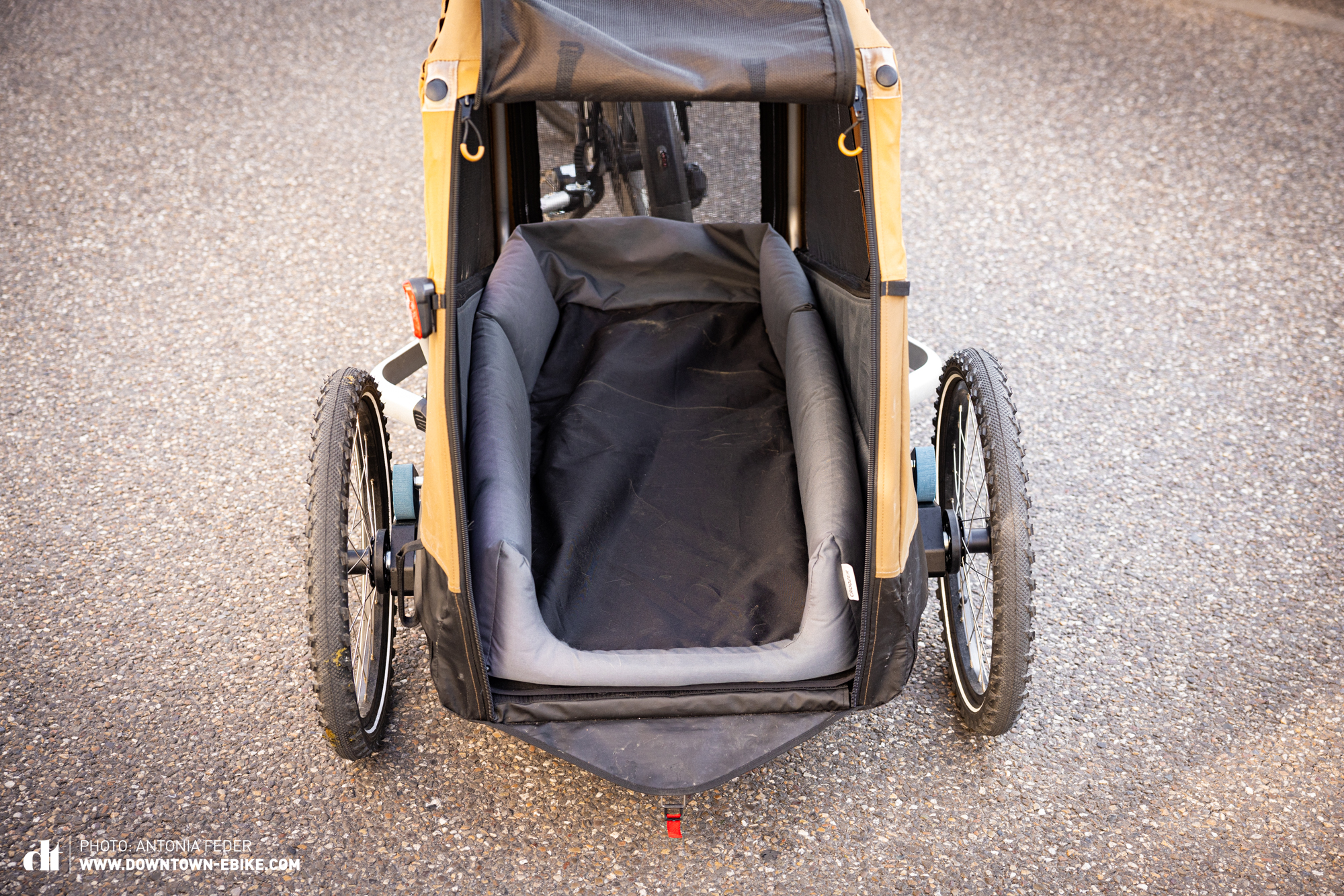

Things to consider before and during a ride
Before hitting the road with your furry sidekick, you’ll need to train them first. There is always the risk that it won’t work out. Patience is key.


Instructions for getting your dog used to the trailer:
- Set up the trailer in familiar surroundings, such as in your apartment or garden.
- If your dog approaches the dog bike trailer, reward them with treats.
- Before letting your dog climb in, make sure that the dog trailer is stable. If it isn’t, your dog may get startled by sudden movement.
- It is best to put treats, food, or a toy in the trailer.
- Be patient!
- Once your dog is in, let them get out right away and reward them.
- For the dog to stay inside, you should make it as comfortable as possible. Put a familiar dog blanket and a chew toy or snack inside the trailer, for example, so that your dog has got some welcome distractions.
- Once your dog stays in the trailer, roll it around in the garden by hand and push it over a curb in front of your house.
- If your dog is relaxed, you can hitch the dog trailer to the bike. Keep a close eye on your dog while riding for the first time. If your pet still looks stressed or anxious, repeat steps 1 to 8 above until your doggo gets comfortable with the trailer life.
- Training, training, training!
- Worst case: if your dog just can’t get the hang of it, the used market for dog bike trailers is relatively stable. 😉

Before heading out on your bike with the dog trailer in tow, there’s a few points to check:
- Is your ebike battery fully charged? The added weight of the trailer will drain the battery quicker.
- You should also increase the rear tire pressure to accommodate the additional weight of the trailer.
- Are the hitch, safety line and drawbar firmly connected? Check how securely the trailer is attached to the bike.
- Is the safety leash (if available) attached to the dog?
- Are all openings closed? Depending on whether your dog is used to trailers and likes to stick his head out, you can leave a window open.
- Road safety check: are all your reflectors still attached? Do you have a tail light for the ride home after sunset? Is the flag attached?
- Put on your helmet! Riding without one makes you look like a fool – topless doesn’t fly around here.
- Is the dog bed in the trailer?
- If the trailer has suspension, the heavier the dog, the harder you must adjust the spring.






On your marks, get set, go! There are a few things to keep in mind while riding, too:
- Adjust your riding style! Unfortunately, you will have to suppress the urge to go racing around in Turbo mode.
- The dog bike trailer increases the length and width of your vehicle significantly.
- If your dog moves around while you’re riding, the weight distribution can change abruptly.
- Expect a longer stopping distance, look ahead, and ride proactively.
- Keep in mind that the turning radius of the trailer is smaller than that of the bike towing it when you corner.
- Due to the increased weight, there is a bigger load bearing on your bike’s wheels, suspension, brake pads, and rotors.

Findings, test winners, and recommendations
The Hamax delivered! As the best in test, it offers the best value for money and is the only trailer in the test field with a side exit. That makes the Hamax a versatile option for dogs of all ages and physical abilities. With its incredibly well-designed, spacious, comfortable, and removable interior for washing, it sets itself apart from the competition. All that’s missing is bigger wheel deflectors and an extra window to keep an eye on your buddy.

If the Hamax doesn’t fit your budget, we recommend taking a look at the Burley Bark Ranger. Even without suspension, this dog bike trailer delivers stable and reliable handling. With a dog bed, the ride comfort is as good as it gets. Unfortunately, the interior isn’t padded and there’s no integrated dog leash. On the upside, it’s super easy to assemble and disassemble, and it even comes with optional pockets for added onboard storage.

If you place more importance on looks and prestige, and you would like to ride off-road, you should take a look at the Croozer. Here, a high-quality finish meets stylish design. At the same time, the Croozer is a comfortable and well-made dog bike trailer. However, there is one big drawback: you’ll need a second pair of hands to help with the assembly, as the fabric canopy is very tight-fitting. In addition, Croozer’s pricing policy is a little misleading: the starting price only includes the basic trailer, and everything else, including the integrated leash and pockets, will cost you extra.

If panorama windows are more important to your dog than design, the TAXXI DOG is an attractive option. Perfect for sightseeing! The integrated rain cover is convenient, though it looks cheap, and the pocket on the roof hangs through to the interior of the dog bike trailer. The biggest drawback with the TAXXI DOG is the drawbar, as it’s too short and tends to drag on the ground when cornering.

For the uncomplicated, who don’t need all the bells and whistles, the Burley Tail Wagon is just the thing. It’s small and simple, but it holds the road well. With a dog bed, it’s just as comfortable as the suspended dog bike trailers on test. It’s a pity that the integrated pockets cannot be completely closed and that there’s no optional rain protector available.

The TRIXIE dog bike trailer is the right choice for the frugalists among us. If you’re on a tight budget and don’t need premium quality, the TRIXIE offers a lot of features and solid functionality. However, the handling stability suffers due to the high centre of gravity and less sturdy construction. It’s okay for urban cruisers, less so for outdoor enthusiasts.

Tops

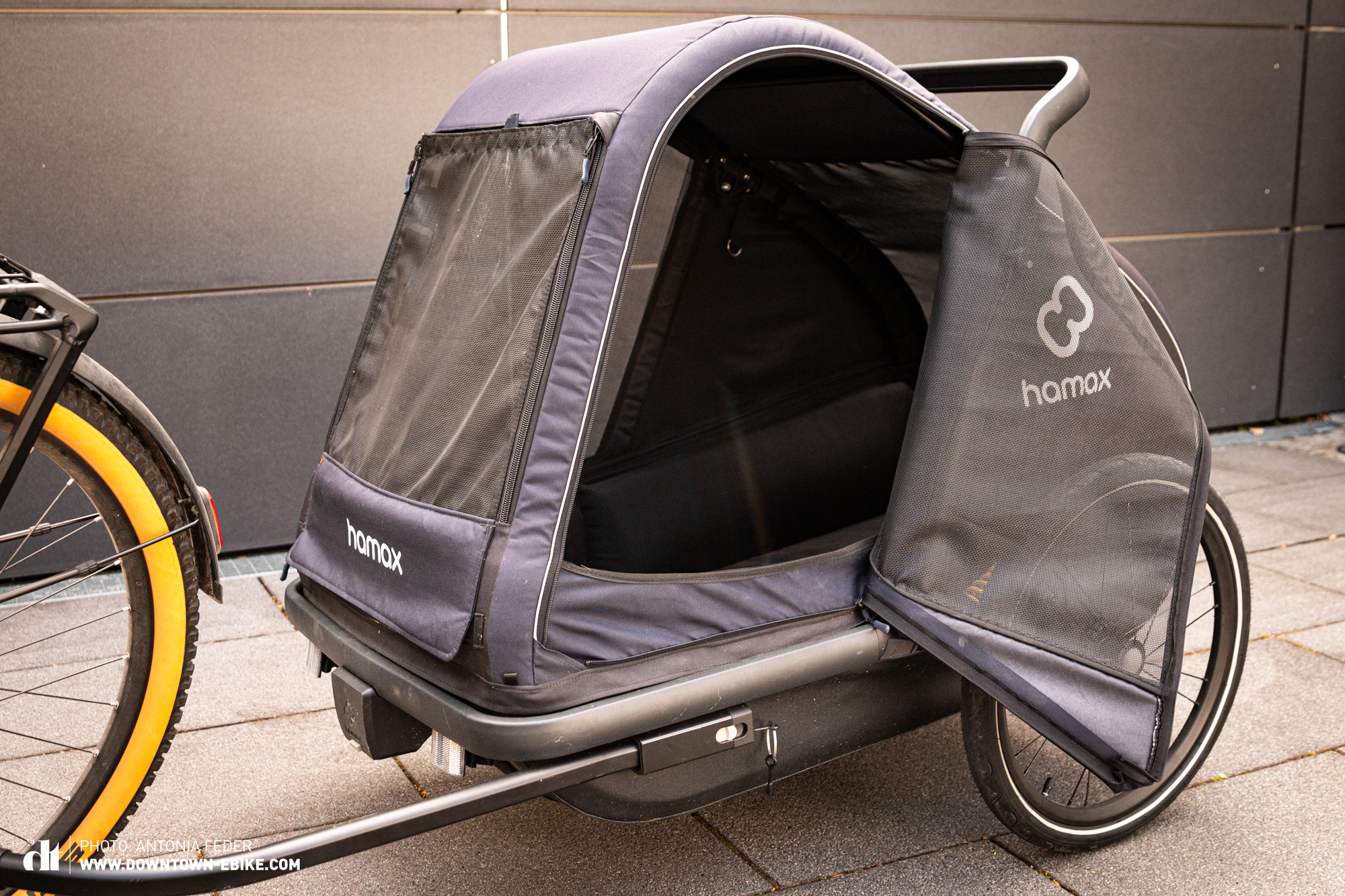
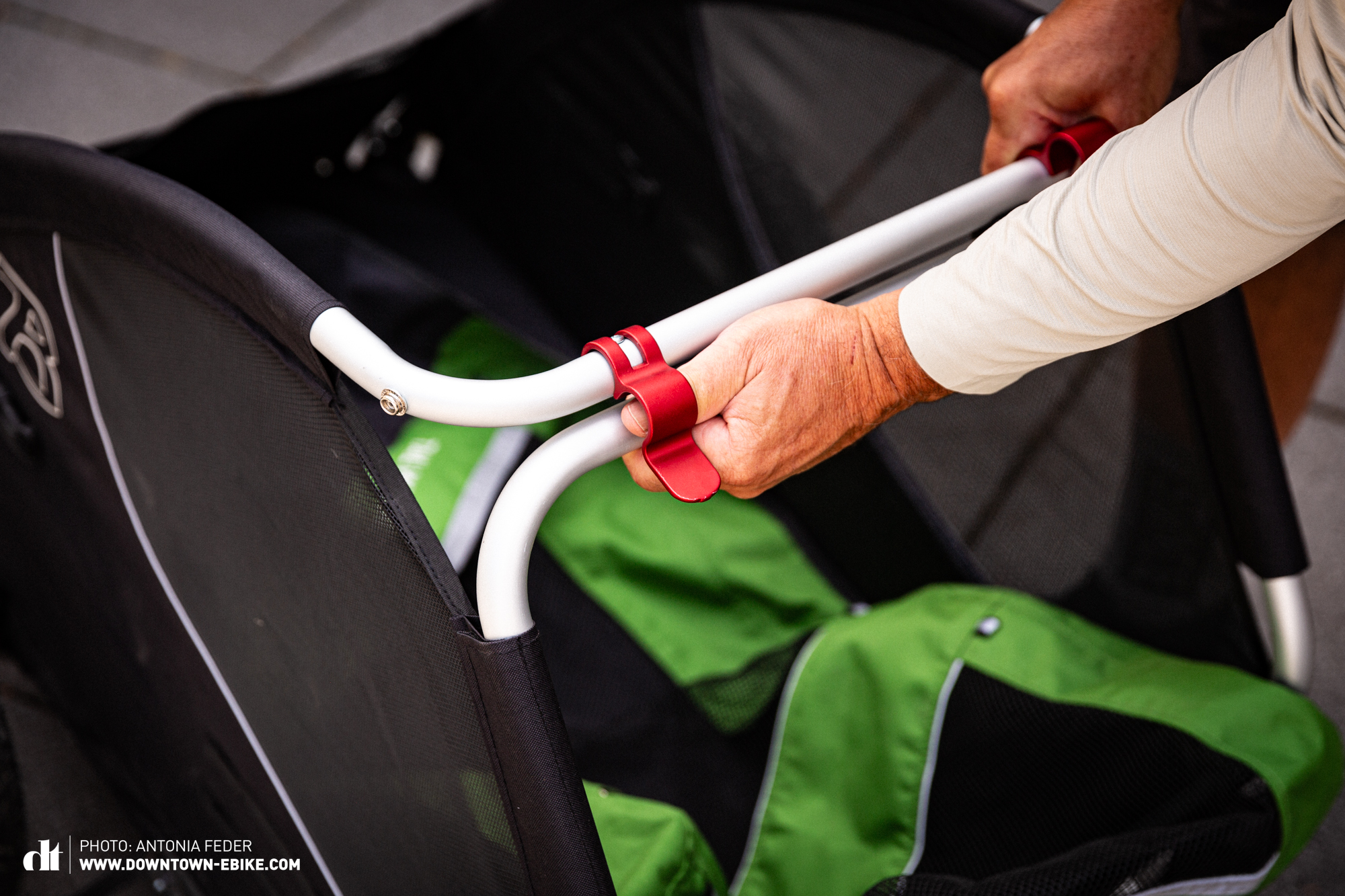

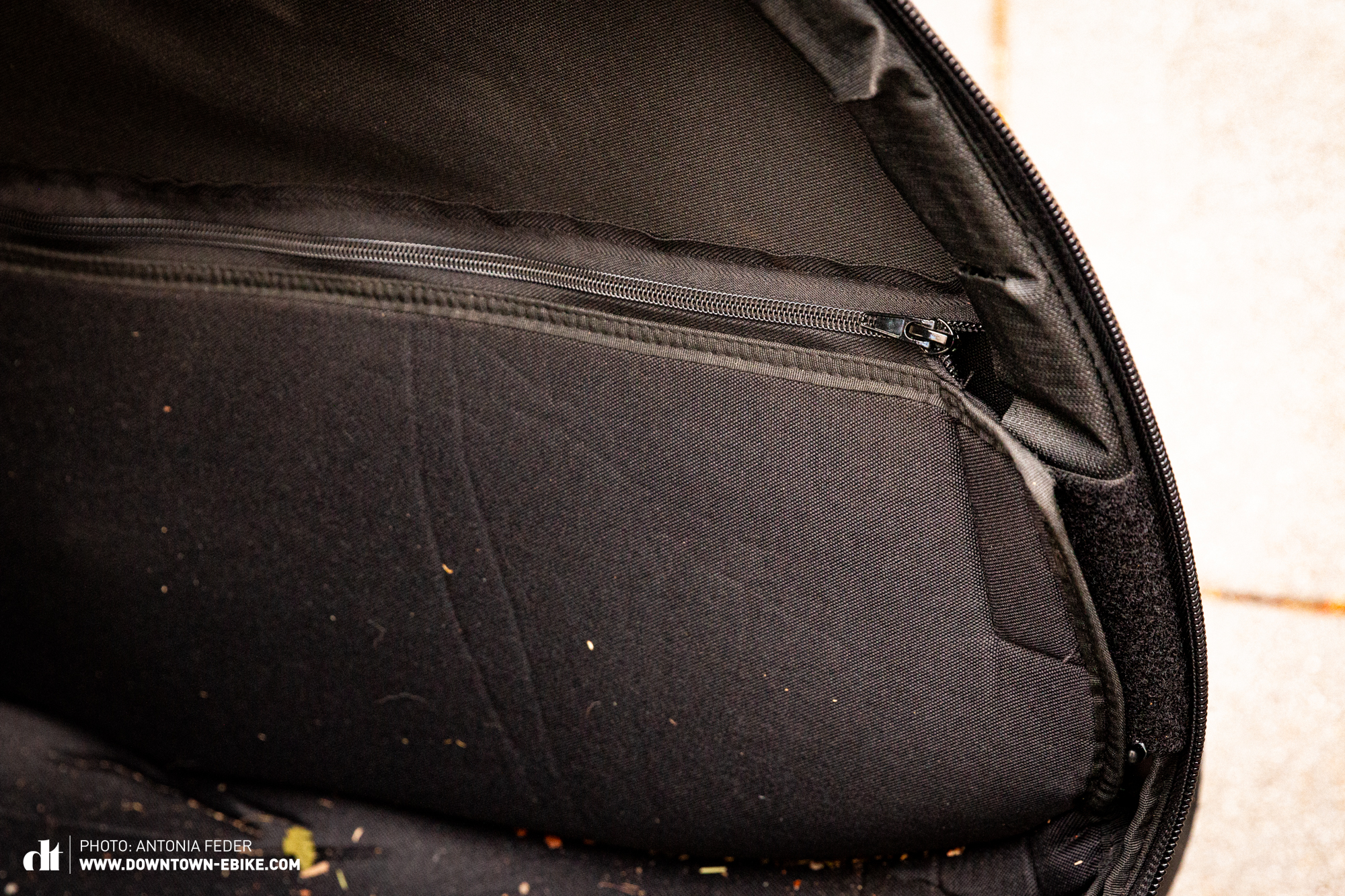

Flops


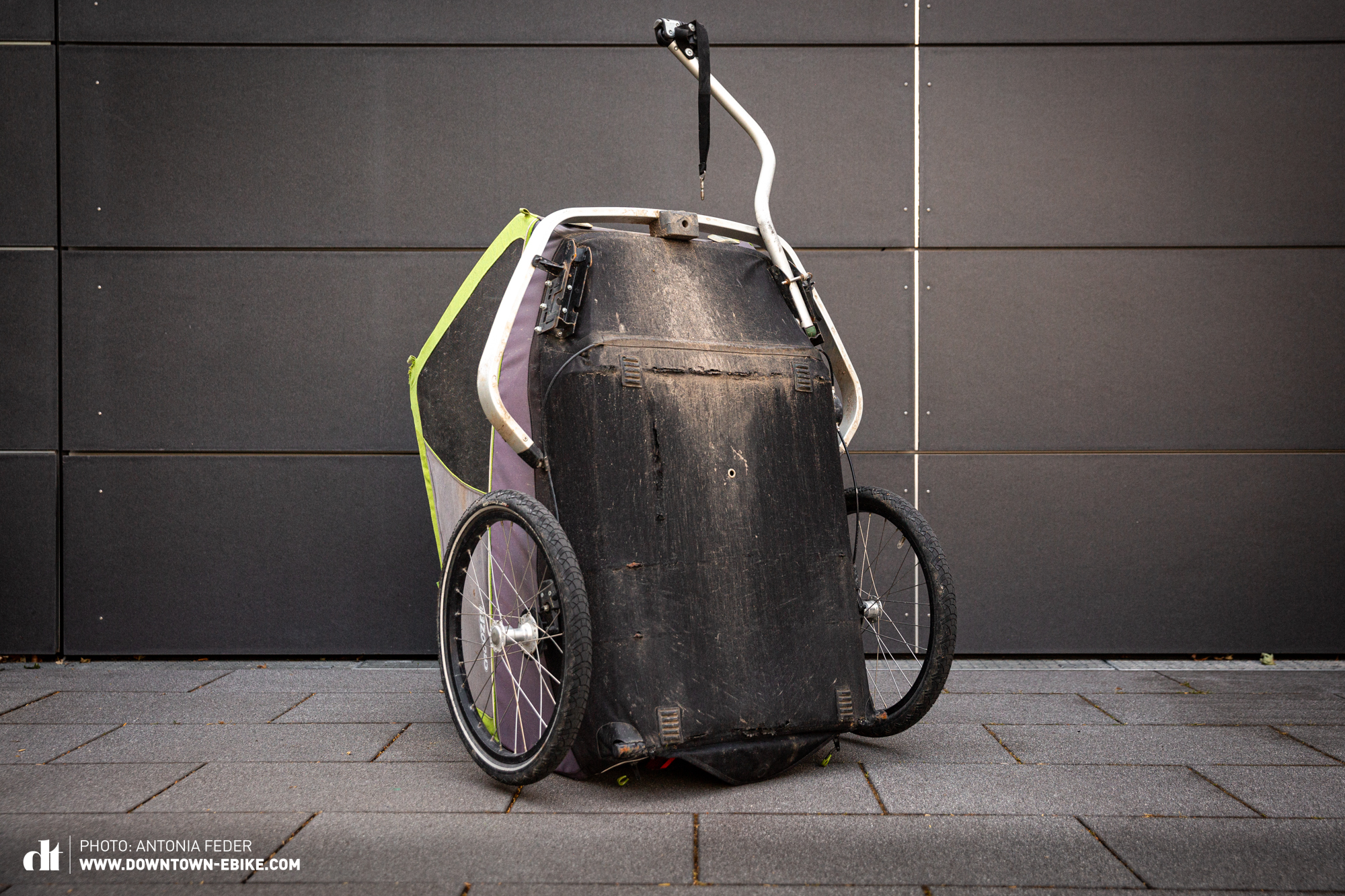

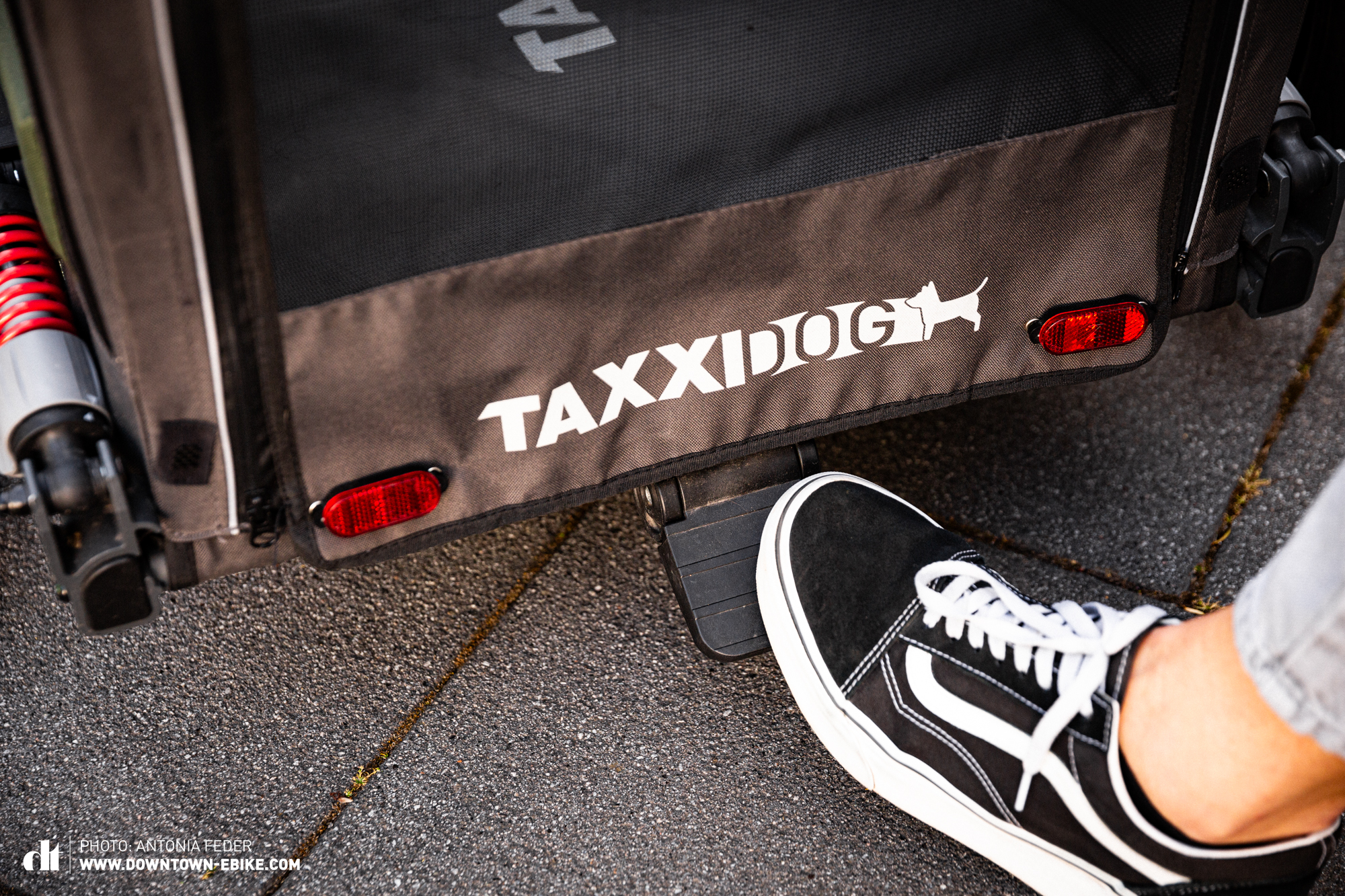

Conclusion
The market for dog bike trailers is as colourful and diverse as our furry test crew. So before buying, ask yourself what you really need, because the best trailer is always the one that caters to you and your dog’s needs best. And before you get hung up on the question of suspension: a good dog bed is more important. With the right equipment, you’ll always have a happy four-legged friend by your side… or, rather, in tow. Happy dog – happy life!
The complete dog bike trailer test field: Croozer | Hamax | TAXXI DOG | TRIXIE | Burley Bark Ranger | Burley Tail Wagon

Words: Antonia Feder Photos: Antonia Feder Robin Schmitt







